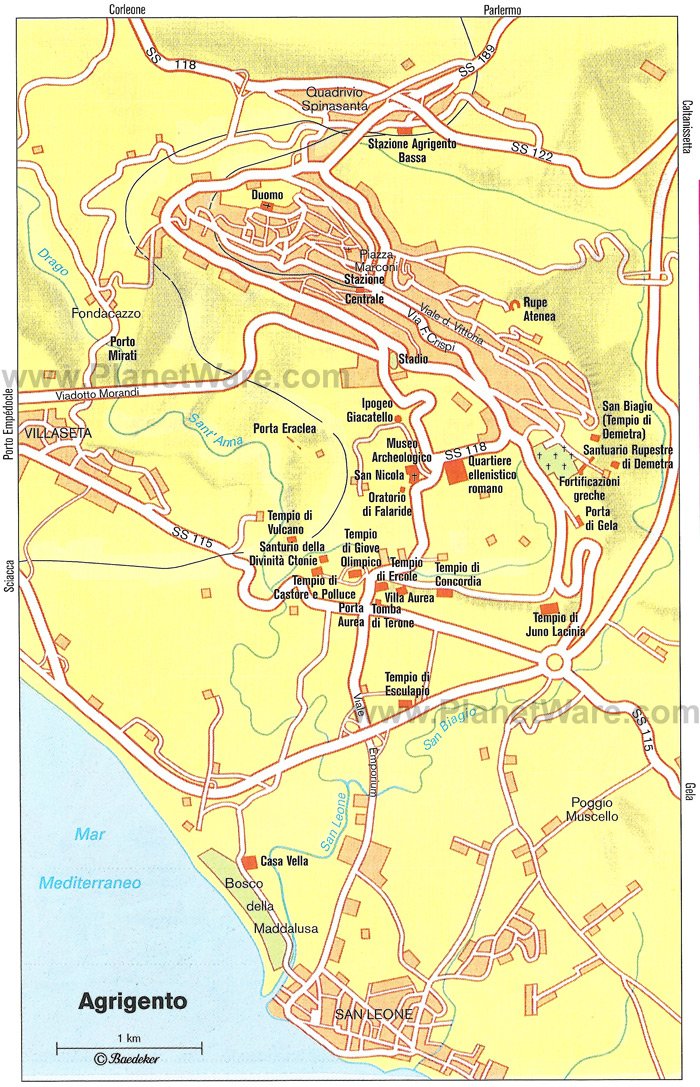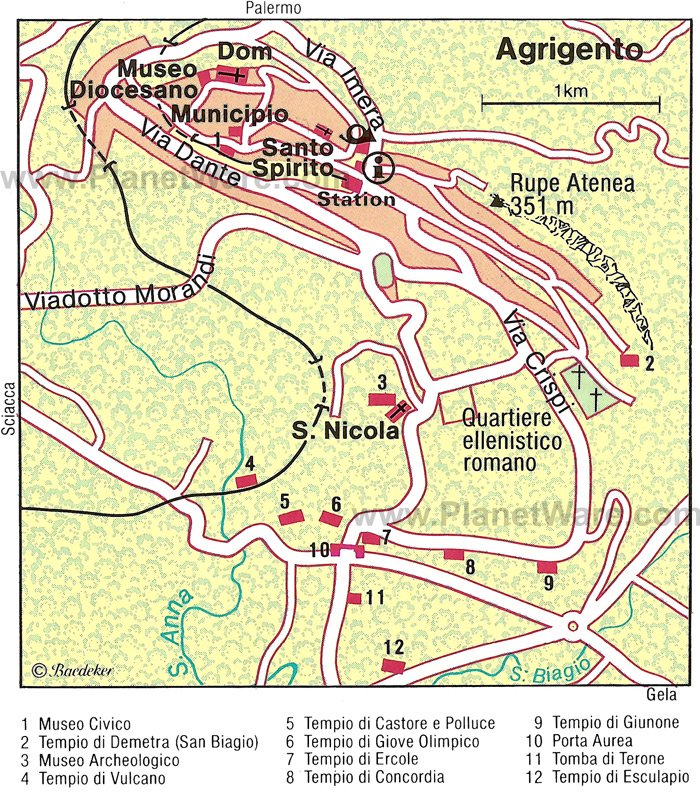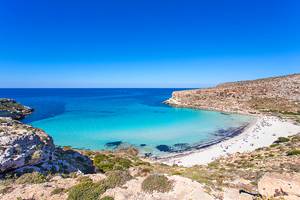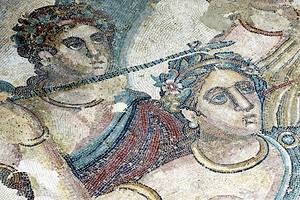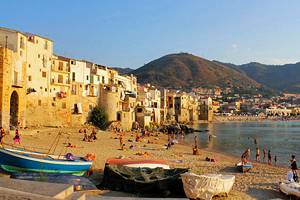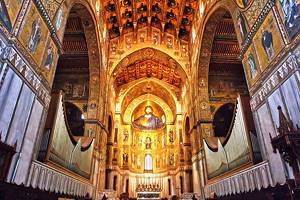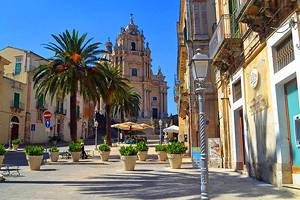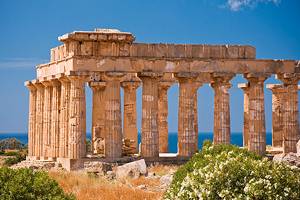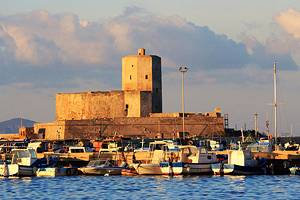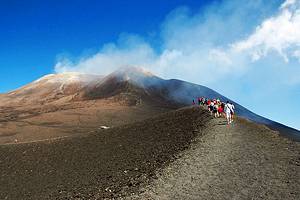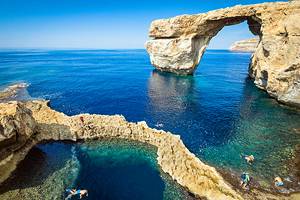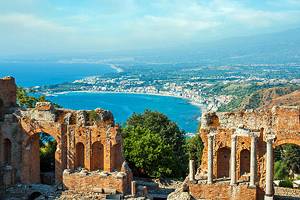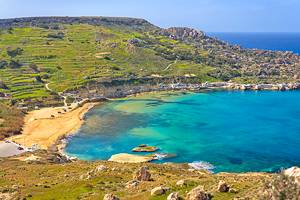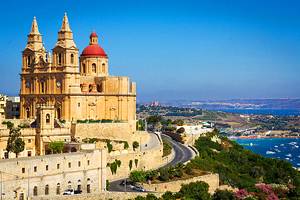Tourist Attractions in Agrigento
Agrigento sits in hilly countryside very close to the southern coast of Sicily, and because of its superb temple ruins, it's one of the most rewarding places to visit in Sicily. The numerous ancient buildings stand in vivid contrast to the modern high-rise blocks that predominate, especially in the southern part of the old town.
Besides these testimonies of antiquity, there are also buildings from both the medieval and Baroque periods that are well worth seeing. Beaches are only a short distance away at Lido San Leone and Porto Empédocle.
Agrigento's main tourist attractions from the Christian era are in the present town center, between the railroad station and the cathedral. The ones dating from ancient times are southeast and south of town, extending to the Valley of the Temples and beyond. Plan your trip with our list of the top attractions and things to do in Agrigento.
- Tempio di Concordia
- Tempio di Juno Lacinia
- Tempio di Giove Olimpico (Temple of the Olympian Zeus)
- Tempio di Castore e Polluce (Temple of Castor and Pollux)
- Tempio di Heracles (Temple of Hercules)
- Museo Archeologico Regionale
- Climb the Scala dei Turchi (Stairs of the Turks)
- Cathedral
- San Biagio
- Santo Spirito
- San Lorenzo
- Kolymbetra Garden
- Day Trip to Sciacca
- Favara's Farm Cultural Park
Tempio di Concordia
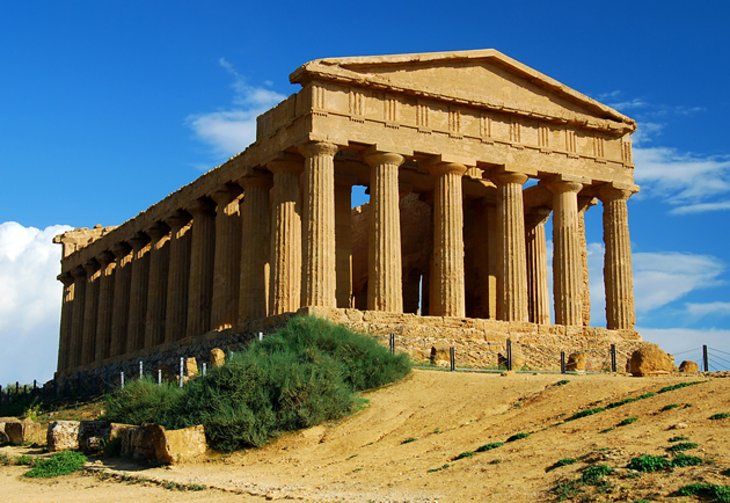
The Valley of the Temples, listed as a UNESCO World Heritage Site, dates back to 500 BC and consists of a series of temples, cemeteries, and tombs. Three of the temples in the eastern group stand together in a row and are illuminated in the evenings.
The best preserved of these, the Temple of Concordia, ranks with the Hephaisteion in Athens and the classical Temple of Hera in Paestum as the most perfect temples in the Greek world; it is the best preserved Doric temple in Sicily and conveys the scale of these ancient, sacred buildings.
The temple was built around 425 BC in classical proportions, with six columns on each of two parallel sides and 13 on the other two. Even its interior follows the style that was the norm in Greece, without the adytum, which was usually to be found in Sicily behind the cella.
Staircases to the left and right of the cella entrance lead to the roof truss, and the building is preserved right up to the roof. This is because in the sixth century it was turned into a Christian church with the cella as a central aisle, and the columns were walled up. The church was abandoned in 1748, and the building has been restored to its original temple appearance.
Address: Valle dei Templi, Agrigento
Tempio di Juno Lacinia
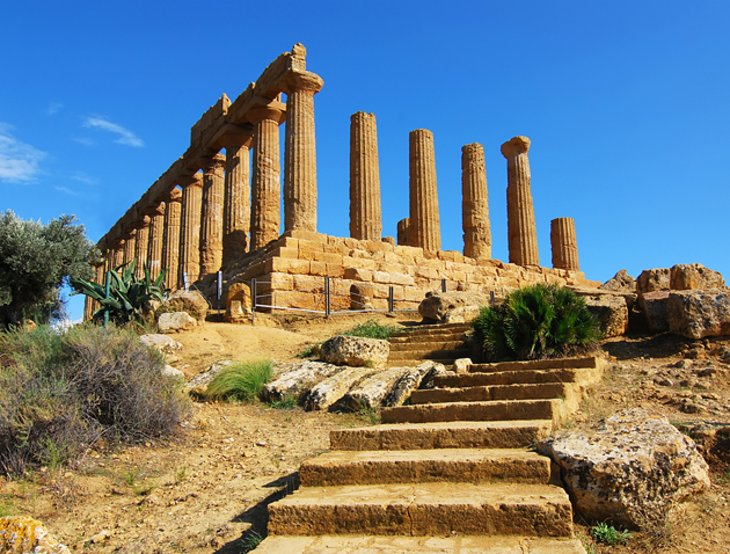
The Temple of Juno (in Greek Hera) Lacinia, sits at the upper end of the eastern row of temples and has a circular hall of six by 13 columns. Of its columns, 25 are still upright. The cella was a room without inner columns. It was given its marble floor later, probably in Roman times.
Its religious symbolism is no longer evident, so it is not known which deity was worshipped here. The temple was destroyed by the Carthaginians and, on being rebuilt by the Romans, was given a ramp leading up to the eastern entrance side. In front of this, you can see the remains of a large sacrificial altar.
Address: Valle dei Templi, Agrigento
Tempio di Giove Olimpico (Temple of the Olympian Zeus)

One of the western temples, the one dedicated to Zeus is today an enormous mass of shattered stone blocks and pillars that an earthquake has scattered over an area of 6,000 square meters. It is difficult to form a picture of the building in its original state without plans or the suggested reconstruction supplied by the Archeological Museum, but it was clearly the largest of the temples.
Built in 480 BC to commemorate Theron's victory over Carthage, it is the largest of all known Doric temples and occupied an area of 56.3 meters by 113.45 meters, with seven columns on each of the narrow sides and 14 on the longer sides. These were about 18.2 meters high and 4.05 meters in diameter at the base.
Architecturally, it was unlike any other known Greek temple, with the spaces between the columns walled in to about halfway up the height of the columns. Above the wall in niches were 38 gigantic figures 7.65 meters tall, one of which is in the Archeological Museum, and a copy is at the temple site. They supported the entablature with pediments decorated by reliefs six meters high, bringing the estimated height of the temple to about 40 meters.
Address: Valle dei Templi, Agrigento
Tempio di Castore e Polluce (Temple of Castor and Pollux)
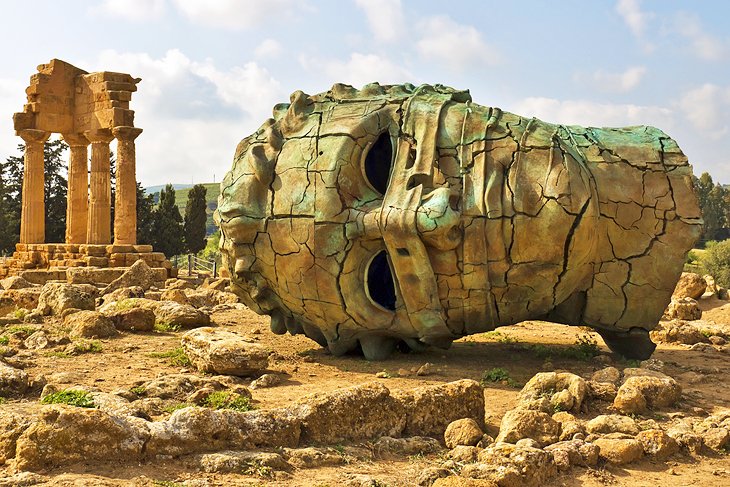
To the west of the Olympieion extends a vast area dating back to the Sicans and extended by the Greeks in the sixth and fifth centuries BC. The Temple of Castor and Pollux at the northwest corner has four columns and a fragment of entablature and pediment standing, rebuilt between 1836 and 1871.
It had colonnades of six by 13 pillars and belonged to the final phase of building when the Greeks wanted to put their stamp on the area with something more impressive than the small older religious buildings.
Address: Valle dei Templi, Agrigento
Tempio di Heracles (Temple of Hercules)
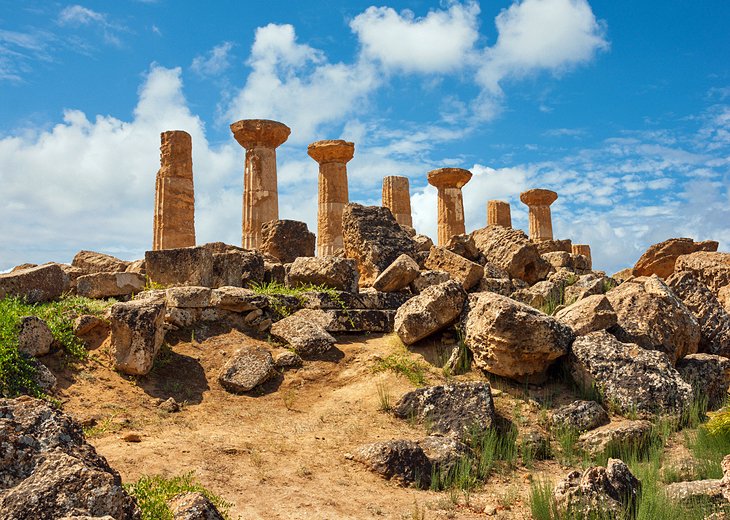
This circular Doric temple was built about 500 BC, with an extensive ground plan and dimensions of six by 15 pillars. The temple was destroyed by the Carthaginians in 406 BC, rebuilt by the Romans, and subsequently destroyed once more by an earthquake.
Even in the ruins, it is still possible to see that behind the entrance to the cella, there were staircases on both sides, which gave access to the roof story. That eight pillars of the south ambulatory are still standing is due to the Englishman Alexander Herdenstel, who in 1923 directed restoration work at his own expense. The original dedicatee of the temple is not known, but in Roman times it was dedicated to Hercules.
Address: Valle dei Templi, Agrigento
Museo Archeologico Regionale
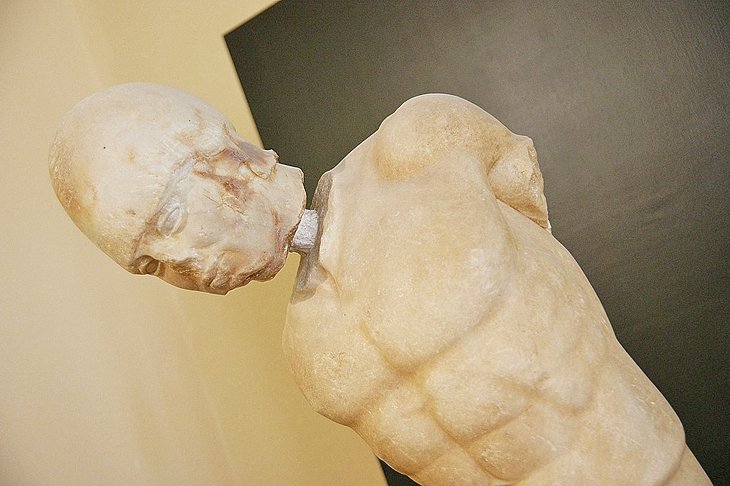
The regional Archaeological Museum is one of the most modern museums in Sicily and contains important archeological finds from the provinces of Agrigento and Caltanissetta dating from prehistoric to Roman times. Among the collections are finds from the Neolithic, Bronze, and Iron Ages and ancient finds from Gela and the necropolis at Montelusa, the oldest known graves in the area.
Highlights to look for include a fifth-century-BC red-figured Greek crater from Gela showing an Amazon battle, black-and red-figured pottery from Athens and Italy dating from the sixth to third centuries BC, capitals and gargoyles with lion's heads from various temples, and the marble statue of an ephebe from about 480 BC.
An entire two-story room is devoted to the buildings of the enormous temple of the Olympian Zeus, with a model and reconstruction drawings and one of the original 38 Atlas figures, the head of another Atlas, and other fragments.
Address: Contrada St. Nicola, I-92100 Agrigento
Climb the Scala dei Turchi (Stairs of the Turks)
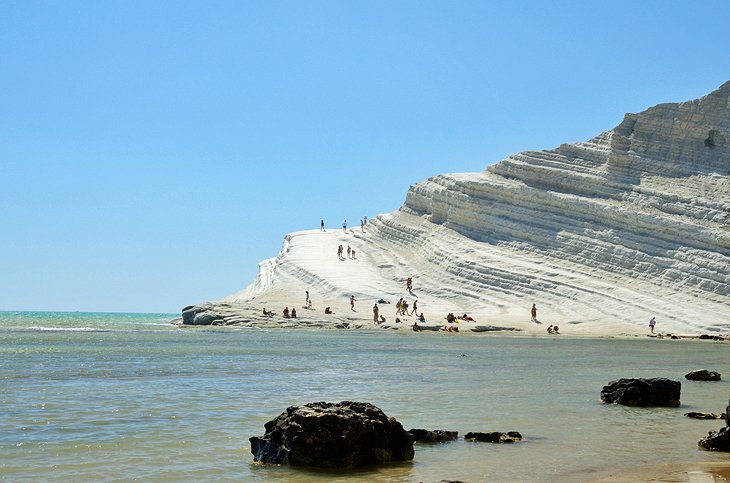
This white rock cliff on the coast, near Porto Empedocle, is formed by marl, a sedimentary rock similar to limestone, whose layered composition causes it to erode in regular step-like layers. It gets its name, Stairs of the Turks, from the frequent raids by Turkish pirates, who found the steps an easy way to climb ashore.
These striking white cliffs lie between two beaches, which combined with their mention in Andrea Camilleri's Commissario Montalbano series, have made them a popular attraction for tourists. The marl sand is also a favorite mud bath, reputed to benefit the skin. The cliffs change color at various times of day, from stark white in the midday sun to golden and luminous at sunset.
Location: Realmonte Agrigento
Cathedral

The cathedral in Agrigento was built in the 11th century by the Normans on the highest point of the site of the ancient Acropolis, where the Temple of Zeus Atabyrios once stood. In the 13th and 14th centuries, the cathedral was extended, and in the 17th century, it was altered in the Baroque style. Next to the massive bell-tower (be sure to notice its ornate balcony), a grand flight of steps leads up to the main doorway.
The interior of the three-aisled basilica was restored after earthquake damage in 1966, and in the process, an attempt was made to recreate the original medieval atmosphere in the nave, retaining from the later changes only the magnificent 1518 wooden ceiling–the highlight of the church–and some of the opulent Baroque decorations in the choir.
Look in the Gothic chapel in the right-hand side aisle, for the silver shrine of the canonized Bishop Gerlando, which dates from 1639. To the west of the cathedral stands the bishop's seminary, a 14th-century palace, which was rebuilt in the 17th and 18th centuries.
Address: Via Duomo, Agrigento
San Biagio
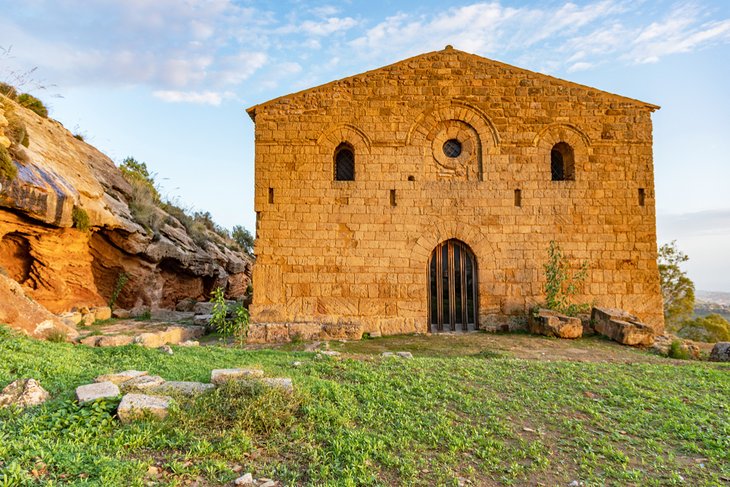
At the eastern end of the 351-meter Rock of Athene (Rupe Atenea), this small church was built in the 12th century under Norman rule using materials salvaged from earlier buildings. It stands on the site of the Temple of Demeter, which would have been erected about 480-460 BC.
You can still see the foundations and parts of the north wall of this temple behind the church's apse. Also look for two round altars to the north of the building, which possibly served as sacrificial sites. Ritual vessels have been found inside these altars, making it possible to identify the shrine.
Follow a stairway down to the rock shrine of Demeter and Persephone, carved into the steep slope of the Rupe Atenea. The oldest known place of worship in Agrigento, it is thought to date back to pre-Greek times in the seventh century BC. Behind a narrow chamber in the rocks are two caves containing springs whose waters are directed through several basins into the courtyard.
Address: Viale della Vittoria, Agrigento
Santo Spirito
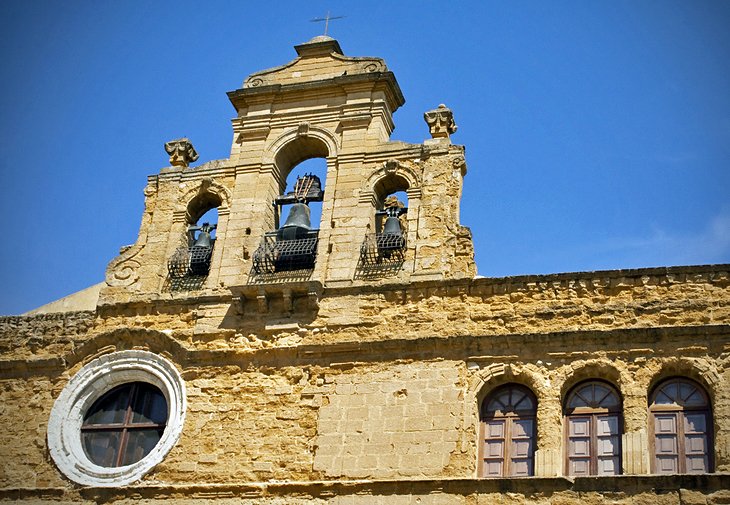
The façade of the former Cistercian monastery of Santo Spirito, dating from about 1260, still has the original Gothic ogival doorway and a rose window, the top of which ends in a Baroque gable. Inside, the walls are decorated with Baroque high reliefs in stucco, attributed to Giacomo Serpotta and completed in the 17th century.
To the right of the church is a doorway leading to the remains of the cloister and to the beautiful doorway of the chapter house, a pointed arch with decorative Arabo-Norman windows. In the adjoining convent, you can buy biscotti and shell-shaped cookies called conchiglia from the nuns, who make them from local pistachios using the old methods and recipes.
Address: Via Santo Spirito, Agrigento
San Lorenzo
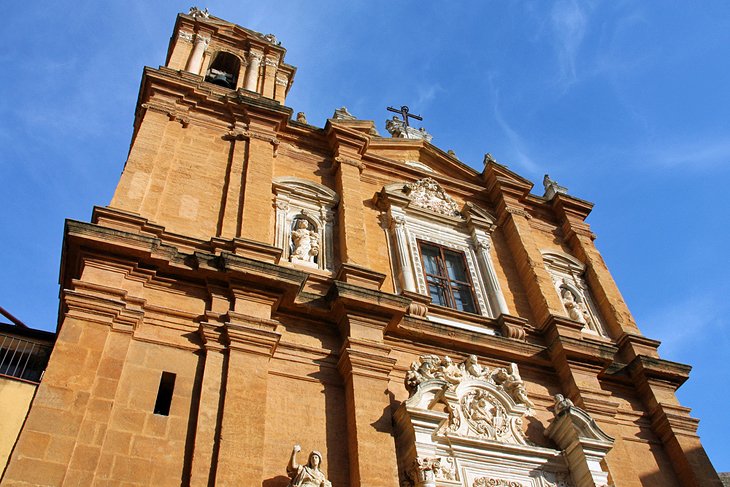
Also known as Chiesa del Purgatorio, Purgatory Church, San Lorenzo was completed in 1761 by a wealthy bourgeois neighborhood. Its splendid façade is in reddish-golden tufa with a white doorway framed in twisted columns. Inside are deep-relief stuccoes done in the late 1600s by Giacomo Serpotta, one of the masters of the Sicilian Baroque style.
Be sure to see the two 17th-century confessionals with carved skulls, the marble statue of the Madonna della Melograna, and the exquisite Chapel of the Crucifix, awash in gold.
Address: Piazza del Purgatorio, Agrigento
Kolymbetra Garden
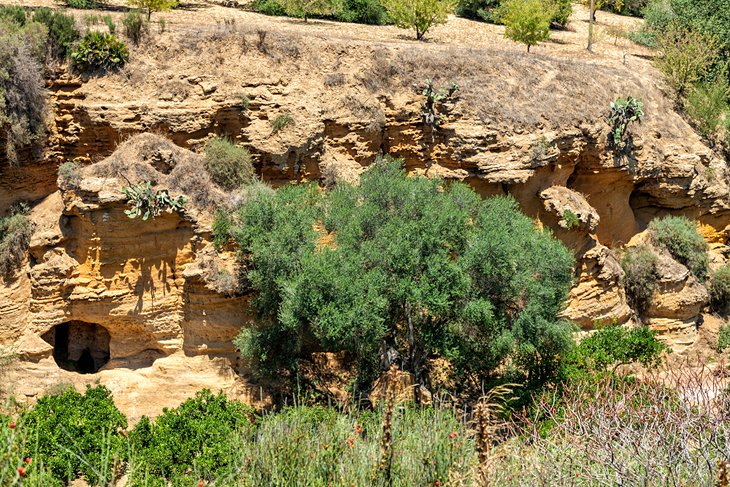
For a shady afternoon respite in the Valley of the Temples, stroll through this working historic garden. The restored groves form an open-air archaeological and agricultural museum showing how citrus trees and other food plants were cultivated more than 2,000 years ago.
Bordering the paths through the garden are orange, lemon, almond, mulberry, and other fruit trees, but bear in mind that this is not a show garden of flower beds. It is a working historical site, where you can see the unique system of underground aqueducts used to bring in water for irrigation.
Day Trip to Sciacca
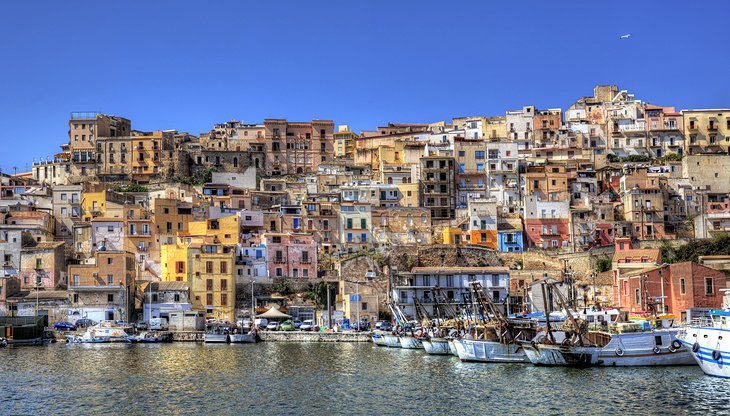
This small fishing port on the southwest coast rises on a hillside above its harbor and has been a popular spa town since Roman times. Apart from the charms of its old streets, its highlights are three churches. The Chiesa del Carmine, which stands next to the 16th-century Baroque town gate, is a triple-aisled Gothic basilica with its original rose window and a later Baroque portal.
The 12th-century cathedral has a 16th-century façade and inside, a multi-sectioned marble tabernacle ascribed to Renaissance sculptor Antonino Gaggini portraying the passion of Christ. West of the cathedral, the deconsecrated Chiesa Santa Margherita was endowed in 1342 and preserves the main door of the original Gothic building. It was rebuilt in 1595, when the rich stucco decoration was added.
Not far from the town gate of Porta San Calägero, you'll find the outer walls and a tower of the 14th-century Castello dei Luna. Sciacca's most unusual attraction, however, is about two kilometers east of town on Via E. Ghezzi. The Castello Incantato was created by Filippo Bentivegna, who carved thousands of heads–devils, knights, gods, and historical figures–from the rocks behind his house in the early 1900s.
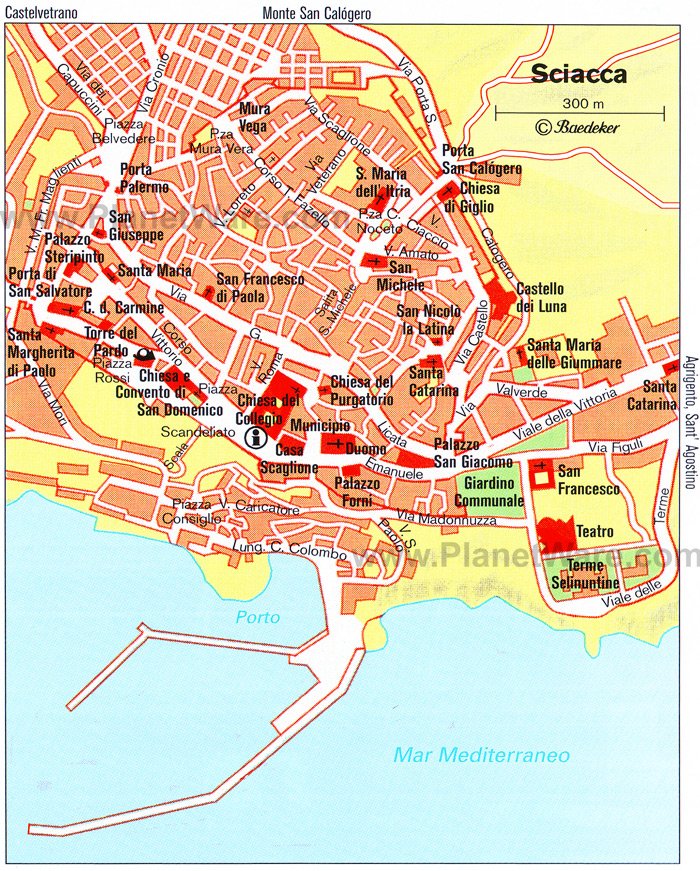
Favara's Farm Cultural Park
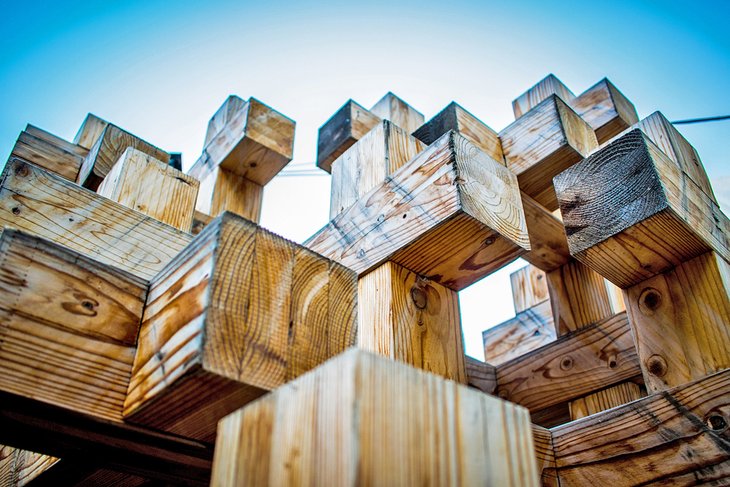
An unusual tourist attraction has sprung up in the past decade in the town of Favara, about five miles from Agrigento. Once almost abandoned, the town center has been transformed into an outdoor art gallery of street murals, sculptures, and installations. It is the largest and most important open-air exhibition of contemporary art in Sicily.
Saving the deteriorating old center and bringing new life to a depressed area, the Farm Cultural Park not only provides a venue for artists, but a center for cultural events, film screenings, and workshops. Much of the street art is politically motivated or fantastical, and along with the painted murals are works in ceramic tile, wood, and other mediums. In addition to the winding art-lined streets, visitors will find shops and a garden café.
More Related Articles on PlanetWare.com
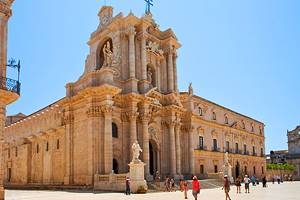
More Ancient Sites in Sicily: Although Agrigento contains a phenomenal concentration of temples, you'll find Greek and Roman theaters and ancient quarries among the tourist attractions of Syracuse, and at Enna is the Villa Romana with its spectacular mosaic floors. Selinunte's acropolis and eight Greek temples are an easy day trip from Trapani.

More Places to See in Sicily: Many of the attractions of Sicily are found in its capital, and you can discover the highlights with the help of our pages on the top tourist attractions of Palermo, and nearby Monreale Cathedral.
